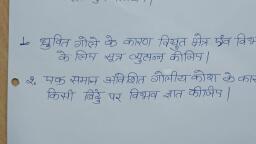Question 1 :
<span class="wysiwyg-font-size-small"><span class="wysiwyg-font-size-small"><p class="wysiwyg-text-align-left">When air is replaced by a dielectric medium of constant $K$, the capacity of the condenser:</p>
Question 2 :
When a thin mica sheet is placed between the plates of a condenser then the amount of charge, so compared to its previous value, on its plates will become:
Question 3 :
Which material sheet should be placed between the plates of a parallel plate condenser in order to increase its capacitance ?
Question 4 :
When a dielectric is introduced between the plates of a condenser, the capacity of condenser :<br/>
Question 5 :
A sheet of aluminium foil of negligible thickness is introduced between the plates of a capacitor. The capacitance of the capacitor :<br/>
Question 7 :
A parallel plate capacitor is charged. If the plates are pulled apart
Question 8 :
The capacity of a parallel plate capacitor with no dielectric substance but with a separation of $0.4cm$ is $2\mu F$. If the separation is reduced to half and it is filled with a dielectric substance of value $2.8$, then the final capacity of the capacitor is
Question 9 :
A capacitor consists of two metal plates each$10{\text{ }}cm$ by$20{\text{ }}cm;$ they are separated by a$2.0{\text{ }}mm$ thick insulator with dielectric constant$4.1$ and dielectric strength 6.0107 V/m. What is the capacitance in$pF\left( {{{10}^{ - 12}}F} \right)?$<br>
Question 10 :
A parallel plate capacitor C is charged by connecting it to a battery using a switch S as shown in the figure, Now S is opened and the plate separation is then increased. As a result:
Question 11 :
Displacement current goes through the gap between the plates of a capacitor when the charge of the capacitor
Question 12 :
If on combining two charged bodies, the current does not flow then :<br/>
Question 13 :
A parallel plate capacitor is charged and then isolated. What is the effect of increasing the plate separation on charge, potential, capacitance, respectively?<br>
Question 14 :
<span class="wysiwyg-font-size-small"><span class="wysiwyg-font-size-small"><p class="wysiwyg-text-align-left">In a parallel plate condenser if the distance between the plates is made half and the dielectric constant is doubled, then the capacity increases by a factor:</p>
Question 15 :
If the inductance and capacitance are both doubled in L-C-R circuit, the resonant frequency of the circuit will :
Question 17 :
<span class="wysiwyg-font-size-small"><span class="wysiwyg-font-size-small"><p class="wysiwyg-text-align-left">The capacity of a parallel plate condenser consisting of two plates each of $10\ cm^2$, separated by a distance of $2\ mm$ is:</p><p class="wysiwyg-text-align-left">(Take air as the medium between the plates)</p>
Question 18 :
Two parallel plate air capacitors have the same separation. The plates of the first are squares of side 10 cm. The plates of the second are squares of side 20 cm. The ratio of their capacitance is :
Question 19 :
A capacitor of capacitance $2\ \mu F$ is charged to a voltage of $6\  V$. The charge on its plates is:
Question 20 :
<span class="wysiwyg-font-size-small"><span class="wysiwyg-font-size-small"><p class="wysiwyg-text-align-left">Force acting upon a charged particle kept between the plates of a charged condenser is F.If one of the plates of the condenser is removed,force acting on the same particle will become</p>
Question 21 :
<span class="wysiwyg-font-size-small"><span class="wysiwyg-font-size-small"><p class="wysiwyg-text-align-left">Select correct Statements : </p><p class="wysiwyg-text-align-left">a) Charge cannot be isolated</p><p class="wysiwyg-text-align-left">b) Repulsion is the sure test to know the presence of charge</p><p class="wysiwyg-text-align-left">c) Waxed paper is dielectric in paper capacitor</p><p class="wysiwyg-text-align-left">d) Variable capacitor is used in tuning circuits in radio</p>
Question 22 :
<p class="wysiwyg-text-align-left"><span class="wysiwyg-font-size-small"><span class="wysiwyg-font-size-small">Three capacitors $2\mu F, 3\mu F$ and $5\mu F$ <span class="wysiwyg-font-size-small"><span class="wysiwyg-font-size-small">are connected in parallel. The capacitance of the combination:</p>
Question 23 :
<p class="wysiwyg-text-align-left">There are $10$ condensers each of capacity $5\; \mu F$. The ratio of minimum to maximum capacity obtained from these condensers will be :<br/></p>
Question 24 :
<p class="wysiwyg-text-align-left"><span class="wysiwyg-font-size-small"><span class="wysiwyg-font-size-small">To obtain $3 \mu F$<i><span class="wysiwyg-font-size-medium"><span class="wysiwyg-font-size-medium"> </i><span class="wysiwyg-font-size-small"><span class="wysiwyg-font-size-small">capacity from three capacitors of <span class="wysiwyg-font-size-medium"><span class="wysiwyg-font-size-medium"><span class="wysiwyg-font-size-small">$2 \mu F$<i><span class="wysiwyg-font-size-medium"><span class="wysiwyg-font-size-medium"> </i><span class="wysiwyg-font-size-small"><span class="wysiwyg-font-size-small">each, they will be arranged as follows:</p>
Question 25 :
From a supply of identical capacitors rated $8\ \mu F, 250\ V$, the minimum number of capacitors required to form a composite $16\ \mu F, 1000\ V$ capacitor is:
Question 26 :
Two capacitors of $1\mu F$ and $2\mu F$ are connected in series and this combination is changed upto a potential difference of $120$ volt. What will be the potential difference across $1 \mu F$ capacitor:
Question 27 :
Four capacitors of equal capacitance have an equivalent capacitance ${ C }_{ 1 }$ when connected in series and an equivalent capacitance ${ C }_{ 2 }$ when connected in parallel. The ratio $\dfrac { { C }_{ 1 } }{ { C }_{ 2 } } $ is
Question 28 :
For capacitors in the series combination, the total capacitance C is given by<br/><br/>
Question 29 :
Find the total capacitance for three capacitors of $10$f,$15$f and $35$f in parallel with each other?
Question 30 :
Two capacitors of capacity $C_1$ and $C_2$ are connected in parallel, then the equivalent capacity is:
Question 31 :
<span class="wysiwyg-font-size-small"><span class="wysiwyg-font-size-small"><p class="wysiwyg-text-align-left">In a charged capacitor the energy is stored in<b>:</b></p><b><span class="wysiwyg-font-size-small"><span class="wysiwyg-font-size-small"></b>
Question 32 :
Two parallel-plate of capacitor have charges +Q and -Q and potential difference $\triangle V$ due to charging, Now the capacitor is disconnected then the potential difference and the stored electrical potential energy is:
Question 33 :
A potential difference of $\Delta V$exists between two plates of a parallel-plate capacitor with capacitance C . A dielectric with a dielectric constant of kis then placed between the plates of the capacitor. What is the energy stored in the capacitor?
Question 34 :
If the charge on the condenser of $10\mu F$ is doubled, then the energy stored in it becomes ____________.
Question 35 :
A capacitor having capacity of $2.0\mu F$ is charged to $200\ V$ and then the plates of the capacitors are connected to a resistance wire. The heat produced in joule will be :
Question 36 :
The capacity of a condenser is 20$\mu F$ $\displaystyle $ and the potential is 20 V. The energy released an discharging it fully will be
Question 37 :
A $2 \mu F$ capacitor is charged to $100 V$ and then its plates are connected by a conducting wire, the heat produced is :
Question 38 :
The energy stored in a capacitor of capacitance C having a charge Q under a potential $V$ is
Question 39 :
The amount of work done is increasing the voltage across the plates of a capacitor from $5V$ to $10V$ is $W$. The work done in increasing it from $10V$ to $15V$ will be :
Question 40 :
The potential energy of system of two equal negative point charges of $2\mu C$ each held 1 m apart in air is ($k = 9 \times 10^9\, SI \,unit$)
Question 41 :
The capacitance of a variable capacitor joined with the battery of $100$V is changed from $2\mu F$ to $10\mu F$. What is the change in the energy stored in it?
Question 42 :
The capacity of a condenser is $4 \times 10^{-6}$ farad and its potential is 100 volts. The energy released on discharging it fully will be
Question 43 :
The energy stored in a capacitor of capacitance $C$ having a charge $Q$ under a potential $V$ is
Question 44 :
A capacitor of capacity C$_{1}$ charged up to V volt and then connected to an uncharged capacitor C$_{2}$.Then final P.D. across each will be:
Question 45 :
$R=100\ k\Omega$ and $C=1\ \mu F$ are connected in a series with a $12\ volt$ battery. What is the maximum energy stored in the capacitor:
Question 46 :
A metallic sphere of radius $18cm$ has been given a charge of $5\times { 10 }^{ -6 }C$. The energy of the charged conductor is :
Question 47 :
A 16 pF capacitor is connected to 70 V supply. The amount of electric energy stored in the capacitor is:
Question 48 :
If a capacitor having capacitance of $1200\mu F$ is charged at a uniform rate of $100\mu C/s$, what is the time required to increase its potential by $20$ volts?
Question 49 :
A parallel plate capacitor of $1\mu F$ capacity is discharging through a resister. If its energy reduces to half in one second. The value of resistance will be?
Question 50 :
<span class="wysiwyg-font-size-small"><span class="wysiwyg-font-size-small"><p class="wysiwyg-text-align-left">The energy stored in a sphere of $10$ cm radius when the sphere is charged to a potential difference of $300$ V is</p>
Question 52 :
A one microfarad capacitor of a TV is subjected to 4000 V potential difference. The energy stored in capacitor is :<br/>
Question 53 :
Consider the two idealised systems<br/>(i) a parallel plate capacitor with large plates and small separation and<br/>(ii) a long solenoid of length $L >> R$, radius of cross - section.<br/>In (i) $\bar{E}$ is ideally treated as a constant between plates and zero outside. In (ii) magnetic field is constant inside the solenoid and zero outside. These idealised assumptions, however, contradict fundamental laws as below.
Question 54 :
Three condensers each of capacitance 2 F, are connected in series. The resultant capacitance will be :<br/>
Question 55 :
If the potential of a capacitor having capacity of $6\mu F$ is increased from 10 V to 20 V, then increase in its energy will be :<br/>
Question 56 :
Which combination of statements is correct?<br><br>i. If electrical resistivity of metal $X$ is lower than that of metal $Y,$ it means metal $X$ is better conductor ofelectricity than metal $Y.$<br><br>ii.If a wire of resistance $8 \Omega$ is doubled on itself, theresistance of the new wire will be $2 \Omega.$<br><br>iii.The coils of electric toasters and irons are made of an alloy rather than a pure metal because resistivity of the alloy is higher than that of its constituentmetals.<br><br>iv.If a conductor of length $65\ cm$ has a resistance of $4\Omega,$ the same conductor of length $260\ cm$ will havethe resistance of $16\Omega.$<br><br>v.The maximum amount of current that can passthrough a conductor is $440\ A.$
Question 57 :
Two long conductors, separated by a distance $d$ carry currents ${I}_{1}$and ${I}_{2}$ in the same direction. They exert a force $F$ on each other. Now the current in one of them is increased to two times and its direction is reversed. The distance is also increases to $3d$. The new value of the force between them is:
Question 58 :
The distance between the plates of a charged parallel plate capacitor is $5\space cm$ and electric field inside the plates is $200\space Vcm^{-1}$. An uncharged metal bar of width $2\space cm$ is fully immersed into the capacitor. The length of the metal bar is same as that of capacitor. The voltage across capacitor after the immersion of the bar is:
Question 59 :
An isolated capacitor with a capacitance C has a potential difference between the plates of V, which leaves on each plate a charge $Q$.<br>A dielectric is then inserted in-between the plates, what affect does this have on the electric field between the plates?
Question 60 :
A dielectric is inserted into a capacitor while keeping the charge constant. Identify what happens to the potential difference and the stored energy?
Question 61 :
A fully charged capacitor has a capacitance C. It is discharged through a small coil of resistancewire embedded in a thermally insulated block of specific heat capacity s and mass m. If the temperature of the block is raised by $\Delta $T, the potential difference V across the capacitance is :<br>
Question 62 :
64 water drops having equal charges combine to form one bigger drop. The capacitance of bigger drop, as compared to that of smaller drop will be :<br/>
Question 63 :
The plates of parallel-plate condenser are being moved away with velocity v. If the plate separation at any instant of time is d then the rate of change of capacitance with time is proportional to
Question 64 :
Two identical sheets of a metallic foil are separated by $d$ and capacitance of the system is $C$ and charged to a potential difference $E$. Keeping the charge constant, the separation is increased by $\ell$. Then the new capacitance and potential difference will be:
Question 65 :
Minimum numbers of$\displaystyle 8\mu F$and 250 V capacitors are used to make a combination of$\displaystyle 16\mu F$and1000 V are:
Question 66 :
Calculate the ratio of the equivalent capacitance of the circuit when two identical capacitors are in series to that when they are in parallel?
Question 67 :
The potential difference between the plate of a capacitor is increased by $20$%. The energy stored on the capacitor increases by:
Question 68 :
Two identical plates of different metals are joined to form a single plate whose thickness is double the thickness of each plate. If the coefficients of conductivity of each plate are 2 and 3 respectively, then the conductivity of the composite plate will be
Question 69 :
A parallel plate capacitor is connected to a battery. The plate are pulled apart with a uniform speed. If $'x'$ is the separation between the plates, then the time rate of change of electrostatic energy of the capacitor is proportional to :<br>
Question 70 :
A parallel plate capacitor has a parallel slab of copper inserted between and parallel to the two plates, without touching the plates. The capacity of the capacitor after the introduction of the copper sheet is:
Question 71 :
A dielectric slab of thickness $6 cm$ is placed between the plates of a parallel plate capacitor. If the distance between plates is reduced by $4 cm$, the capacity of the capacitor remains the same. Find the dielectric constant of the medium.<br/>
Question 73 :
<p>Four equal charges $Q$ are placed at the four corners of a square of side '$a$' each. Work done in removing a charge  $-Q$ from its centre to infinity is:</p>
Question 74 :
<span class="wysiwyg-font-size-small"><span class="wysiwyg-font-size-small"><p class="wysiwyg-text-align-left">A dielectric of thickness $5$ cm and a dielectric constant $10$ is introduced between the plates of a parallel plate capacitor having plate area $500 sq.$ cm and separation between the plates $10cm$. The capacitance of the capacitor with the dielectric slab is $\varepsilon _{0}=8.8\times 10^{-12}C^{2}/N-m^{2}$</p>
Question 75 :
An air filled parallel plate condenser has a capacity of $2pF$. The separation of the plates is doubled and the inter-space between the plates is filled with wax. If the capacity is increased to $6$pF, the dielectric constant of wax is.<br>
Question 76 :
A parallel plate capacitor of capacity $C_\circ{}$ is charged to a potential $V_\circ{}$ .The energy stored in the capacitor when the battery is disconnected and the plate separation is doubled is $E_1$ and the energy stored in the capacitor when the charging battery is kept connected and the separation between the capacitor plates is doubled is $E_{2}$. Then value of $\dfrac{E_{1}}{E_{2}}$ is:
Question 77 :
Water is not used as a dielectric between the plates of a capacitor because its.
Question 78 :
The potential across a $25.0$ microfarad capacitor is $5.0 V$.What is the charge on the capacitor?
Question 79 :
A parallel plate capacitor is charged and then isolated. The effect of increasing the plate separation on the capacitance is :<br/>
Question 81 :
Two large vertical and parallel metal plates having a separation of 1 cm are connected to a DC voltage source of potential difference X. A proton is released at rest midway between the two plates. It remains at rest in the air then X is:<br/>
Question 82 :
The energy required to charge a parallel plate condenser (capacitor) of plate separation $d$ and plate area of cross-section $A$ such that the uniform electric field between the plates is $E$, is :
Question 83 :
In a $AC$ circuit the potential difference across an inductance and resistance joining in series are respectively $16\ V$ and $20\ V$. The total potential difference across the circuit is:
Question 84 :
An oil condenser has a capacity of $100\; \mu F$ . The oil has dielectric constant 2. When the oil leaks out , its new capacity is :<br/>
Question 85 :
A 100 $\mu$F capacitor in series with a $40 \Omega$ resistor is connected to a 100 V, 60 Hz supply. The time lag between the current maximum and the voltage maximum is
Question 86 :
The separation between the plates of a parallel-plate capacitor is made double while it remains connected to a cell :<br/>
Question 87 :
Two large, identical and parallel conducting plates have surface X and Y, facing each other. The charge per unit area on X is $\sigma_1$, and on Y it is $\sigma_2$. Then :
Question 88 :
The plates of a parallel plate capacitor have an area of $90cm^2$ each and are separated by $2.5 mm$. The capacitor is charged by a $400$ volt supply. How much electrostatic energy is stored by the capacitor?<br/>
Question 89 :
A capacitors is charged to store an energy $U$. The charging battery is disconnected. An identical capacitor is now connected to the first capacitor in parallel. The energy in each of the capacitors is<br/>
Question 90 :
$S_1$ and $S_2$ are two equipotential surfaces on which the potentials are not equal. Then-
Question 91 :
If the capacity of a spherical conductor is $1$ picofarad, then its diameter would be
Question 92 :
The work done in placing a charge of $8\times 10^{-18}$ coulomb on a condenser of capacity 100 micro-farad is :<br/>
Question 93 :
Where should $q_3$ be placed to make the 'potential energy of the system equal to zero ?
Question 94 :
Two plates are placed at a separation of 2 cm. An electron placed at the perryferry of one plate reaches the second plate in 2 microsecond. Calculate the inner charge density of the surface assuming the case of infinite plate.
Question 95 :
A metal rod of length $10$cm and a rectangular cross section of $1$cm $\times \dfrac{1}{2}$Cm is connected to a battery across opposite faces. The resistance will be.
Question 96 :
A parallel plate air capacitor has a capacitance $C$.When it is half filled with a dielectric ofdielectric constant $5$, the percentage increase inthe capacitance will be :<br>
Question 97 :
If the dielectric constant and dielectric strength be denoted by $K$ and $X$ respectively, then a material, suitable for use as a dielectric in a capacitors, must have :<br>
Question 98 :
How much power is used in moving a $0.03C$ charge from point A at a potential of $40V$ to point B at $60V$, if this takes 2 seconds?
Question 99 :
The radius of a hypothetical nucleus (atomic number$=79$) is about $7\times10^{-15}$ m. Assuming that charge distribution is uniform, the electric field at the surface of the nucleus is :
Question 100 :
<span class="wysiwyg-font-size-small"><span class="wysiwyg-font-size-small"><p class="wysiwyg-text-align-left">A number of identical condensers are first connected in parallel and then in series. The equivalent capacitance are found to be in the ratio $9:1$. The number of condensers used is :<br/></p>
Question 101 :
The following operation can be performed on a capacitor:<br>X connect the capacitor to a battery of emf E.<br>Y disconnect the battery.<br>Z reconnect the battery with the polarity reversed.<br>W insert a dielectric slab in the capacitor.
Question 102 :
Assertion: STATEMENT-1 : To put a dielectric plate in the inter space between two plates of a capacitor connected to a D.C. voltage external agency has to do negative work.
Reason: STATEMENT-2 : Putting the dielectric increases the capacitance.
Question 103 :
A parallel plat capacitor is made of two circular plates separated by a distance of $5 mm$ and with a dielectric of dielectric constant $2.2$ between them. When the electric field in the dielectric is $3 \times 10^4$V/m, the charge density of the positive plate will be close to:
Question 104 :
The plates of a parallel plate capacitor are charged upto $100 V$.A $2 mm$ thick insulator shunt is inserted between the plates . Then to maintain the same potential difference ,the distance between the same potential difference , the distance between the capacitor plates is increased by $ 1.6 mm$.The dielectric constant of the insulator is
Question 105 :
A parallel-plate capacitor of plate area $A$ and plate separation $d$ is charged to a potential difference and then the battery is disconnected. A slab of dielectric constant $K$ is then inserted between the plates of the capacitor so as to fill the whole space between the plates. Find the work done on the system the process of inserting the slab.
Question 106 :
A parallel-plate air capacitor of capacitance $245 pF$ has a charge of magnitude $0.148\mu C$ on each plate. The plates are $0.328 mm$ apart. What is the surface charge density on each plate?<br/>
Question 107 :
The displacement current flows in the dielectric of a capacitor when the potential difference across its plate<br/>
Question 108 :
If an electron enters into a space between the plates of a parallel plate capacitor at an angle $\alpha$ with the plates and leaves at an angle $\beta$ to the plates. The ratio of it's kinetic energy while entering the capacitor to that leaving will be :<br/>
Question 109 :
At the moment $t=0$, an electron leaves one plate of a parallel-plate condenser with a negligible velocity. An accelerating voltage varying as $V=at$, where $a$ is a constant is applied between the plates. The separation between the plates is $l$. The velocity of the electron at the moment it reaches the opposite plate will be :<br/>
Question 110 :
In 1909, Robert Millikan was the first to find the charge of an electron in his now-famous oil-drop experiment. In that experiment, tiny oil drops were sprayed into a uniform electric field between a horizontal pair of oppositely charged plates.The drops were observed with a magnifying eyepiece, and the electric field was adjusted so that the upward force on some negatively charged oil drops was just sufficient to balance the downward force of gravity. That is, when suspended, upward force qE just equaled mg. Millikan accurately measured the charges on many oil drops and found the values to be whole number multiples of $1.6  \times 10^{-19} C$ the charge of the electron. For this, he won the Nobel prize. If a drop of mass $1.08 \times 10^{-14} kg$ remains stationary in an electric field of $1.68 \times 10^5 NC^{-1}$, then the charge of this drop is :<br/>
Question 111 :
A parallel plate air capacitor has a initial capacitance $C$. If plate separation is slowly increased from ${d}_{1}$ to ${d}_{2}$, then mark the correct statement(s). (Take potential of the capacitor to be constant, i.e., throughout the process it remains connected to battery.)<br>
Question 112 :
A capacitor of capacitance ${C}_{0}$ is charged to a potential ${V}_{0}$ and then isolated. A small capacitor $C$ is then charged from ${C}_{0}$, discharged and charged again. This process is being repeated $n$ times. Due to this, the potential of the larger capacitor is decreased to $V$. The value of $C$ is :<br/>
Question 113 :
A parallel plate condenser with a dielectric of dielectric constant $K$ between the plates has a capacity $C$ and is charged to a potential $V$ volt. The dielectric slab is slowly removed from between the plates and then reinserted. The net work done by the system in this process is :<br>
Question 114 :
Two similar parallel plate capacitors each of capacity $C_o$ are connected in series, The combination is connected with a voltage source of $V_o$. Now separation between the plates of one capacitor is increased by a distance $d$ and the separation between the plates of another capacitor is decreased by the distance $d/2$ The distance between the plates of each capacitor was $d$ before the change in separation. Then, select the correct choice :<br/>
Question 115 :
A parallel plate capacitor is charged from a cell and then isolated from it. The separation between the plates is now increased :<br/>
Question 116 :
A parallel plate capacitor is charged and then the battery is disconnected, When the plates of the capacitor are brought closer, then<br>
Question 117 :
A parallel plate capacitor is charged and then disconnected from the charging battery. If the plates are now moved farther apart by pulling at them by means of insulating handles, then:
Question 118 :
The energy of a parallel plate capacitor when connected to a battery is $E$. With the battery still in connection, if the plates of the capacitor are separated so that the distance between them is twice the original distance, then electrostatic energy becomes :<br/>
Question 119 :
A fully charged capacitor has a capacitance $C$. It is discharged through a small coil of resistance wire, embedded in a block of specific heat $s$ and mass $m$ under thermally isolated conditions. If the temperature of the block is raised by $\displaystyle \Delta T$, the potential difference $V$ across the capacitor initially is:
Question 120 :
<span class="wysiwyg-font-size-small"><span class="wysiwyg-font-size-small"><p class="wysiwyg-text-align-left">The plates of a parallel plate capacitor are charged to $200\ V$ and then, the charging battery is disconnected. Now, a dielectric slab of dielectric constant $5$ and thickness $4\ mm$ is inserted between the capacitor plates. To maintain the original capacity, the increase in the separation between the plates of the capacitor is:</p>
Question 121 :
In 1909, Robert Millikan was the first to find the charge of an electron in his now-famous oil-drop experiment. In that experiment, tiny oil drops were sprayed into a uniform electric field between a horizontal pair of oppositely charged plates.The drops were observed with a magnifying eyepiece, and the electric field was adjusted so that the upward force on some negatively charged oil drops was just sufficient to balance the downward force of gravity. That is, when suspended, upward force qE just equaled mg. Millikan accurately measured the charges on many oil drops and found the values to be whole number multiples of $1.6  \times 10^{-19} C$ the charge of the electron. For this, he won the Nobel prize. Extra electrons on this particular oil drop (given the presently known charge of the electron) are :<br/>
Question 122 :
<span class="wysiwyg-font-size-small"><span class="wysiwyg-font-size-small"><p class="wysiwyg-text-align-left">A parallel plate capacitor with air between the plates has a capacitance of $10\mu F$. The area of the capacitor is divided into two equal halves and filled with two media having dielectric constants $K_{1}=2$ and $K_{2}=4$. The capacitance of the system will be:<br/></p>
Question 123 :
Assertion: If three capacitors of capacitance $C_1 < C_2 < C_3$ are connected in parallel then their equivalent capacitance $C_{parallel} > C_{series}$
Reason: $\dfrac {1}{C_{parallel}}=\dfrac {1}{C_1}+\dfrac {1}{C_2}+\dfrac {1}{C_3}$
Question 124 :
A series combination of $n_1$ capacitors, each of value $C_1$, is charged by a source of potential difference 4 V. When another parallel combination of $n_2$ capacitors, each of value $C_2$, is charged by a source of potential difference V, it has the same (total) energy stored in it, as the first combination has. The value of $C_2$, in terms of $C_1$, is then<br>
Question 125 :
A very thin metal sheet is inserted halfway between the parallel plates of an air-gap capacitor. The sheet is thin compared to the distance between the plates, and it does not touch either plate when fully inserted. The system had capacitance, $C$, before the plate is inserted.<br>What is the equivalent capacitance of the system after the sheet is fully inserted?
Question 126 :
A parallel plate condenser has two circular metal plates of radius 15 cm. It is being charged so that electric field in the gap between its plates rises steadily at the rate of $10^12V/ms.$ what is the displacement current?
Question 127 :
A capacitor is charged by a cell of emf $E$ and the charging battery is then removed. If an identical capacitor is now inserted in the circuit in parallel with the previous capacitor, the potential difference across the new capacitor is :<br/>
Question 128 :
Two capacitors connected in parallel having the capacities $C_1$ and $C_2$ are given $'q'$ charge, which is distributed among them. The ratio of the charge on $C_1$ and $C_2$ will be :
Question 129 :
Three capacitance of capacity $10 \mu F , 5 \mu F $ are connected in parallel. The total capacity will be :
Question 130 :
A parallel plate capacitor has $91$ plates, all are identical and arranged with same spacing between them. If the capacitance between adjacent plates is $3\ pF$. What will be the resultant capacitance?
Question 131 :
The work done in placing a charge of $8\times  10^{-18} C$ on a condenser of capacity $100\mu F$ is :<br/>
Question 132 :
A parallel plate capacitor is charged and then the battery is disconnected, When the plates of the capacitor are brought closer, then<br>
Question 133 :
A parallel plate capacitor is charged from a cell and then isolated from it. The separation between the plates is now increased :<br/>
Question 134 :
A parallel plate condenser with a dielectric of dielectric constant $K$ between the plates has a capacity $C$ and is charged to a potential $V$ volt. The dielectric slab is slowly removed from between the plates and then reinserted. The net work done by the system in this process is :<br>
Question 135 :
A parallel plate air capacitor has a initial capacitance $C$. If plate separation is slowly increased from ${d}_{1}$ to ${d}_{2}$, then mark the correct statement(s). (Take potential of the capacitor to be constant, i.e., throughout the process it remains connected to battery.)<br>
Question 136 :
A parallel plate capacitor is charged and then disconnected from the charging battery. If the plates are now moved farther apart by pulling at them by means of insulating handles, then:
Question 137 :
A fully charged capacitor has a capacitance $C$. It is discharged through a small coil of resistance wire, embedded in a block of specific heat $s$ and mass $m$ under thermally isolated conditions. If the temperature of the block is raised by $\displaystyle \Delta T$, the potential difference $V$ across the capacitor initially is:
Question 138 :
The energy of a parallel plate capacitor when connected to a battery is $E$. With the battery still in connection, if the plates of the capacitor are separated so that the distance between them is twice the original distance, then electrostatic energy becomes :<br/>
Question 139 :
A fully charged capacitor has a capacitance '$C$'. It is discharged through a small coil of resistance wire embedded in a thermally insulated block of specific heat capacity '$s$' and mass '$m$'. If the temperature of the block is raised $'\Delta T'$, the potential difference '$V$' across the capacitance is :<br/>
Question 140 :
A fully charged capacitors has a capacitance $'C'$. It is discharged through a small coil of resistance wire embedded in a thermally insulated block of specific heat capacity $s$ and mass $m$. If the temperature of the block is raised by $\Delta T$, the potential difference $V$ across the capacitor is :<br/>
Question 141 :
A parallel-plate vacuum capacitor with plate area $A$ and separation $x$ has charges $+Q$ and $-Q$ on its plates. The capacitor is disconnected from the source of charge, so the charge on each plate remains fixed. What is the total energy stored in the capacitor?<br/>
Question 142 :
A$\displaystyle 40\mu F$capacitor in a defibrillator is charged to $3000 V$.The energy stored in the capacitor is setthrough the patient during a pulse of duration $2ms$, The power delivered to the patient is :
Question 143 :
The energy required to charge a parallel plate condenser of plate separation d and plate area of cross-section A such that the uniform electric field between the plates is E, is :<br/>
Question 144 :
A parallel plate capacitor without any dielectric within its plates, has a capacitance C, and is connected to a battery of emf V. The battery is disconnected and the plates of the capacitor are pulled apart until the separation between the plates is doubled. What is the work done by the agent pulling the plates apart, in this process?
Question 145 :
Three capacitors of same capacitance are connected in parallel When they are connected to a cell of $2$ volt, total charge of $1.8 \mu C$ is accumulated on them. Now after discharging they are connected m series and then charged by the same cell The total charge stored in them will be:
Question 146 :
Two condensers of capacity $0.3 \mu F$ and $0.6 \mu F$ respectively are connected in series. The combination is connected across a potential of $6$ volts. The ratio of energies stored by the condensers will be:
Question 148 :
<span class="wysiwyg-font-size-small"><span class="wysiwyg-font-size-small"><p class="wysiwyg-text-align-left">A parallel plate capacitor has area of each plate A, the separation between the plates is d. It is charged to a potential V and then disconnected from the battery. The amount of work done in filling the capacitor completely with a dielectric constant k is :<br/></p>



























